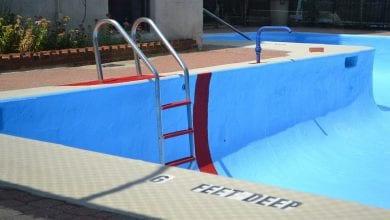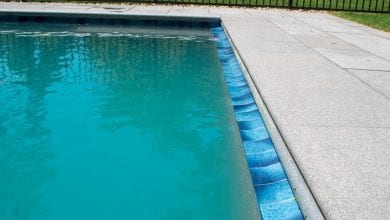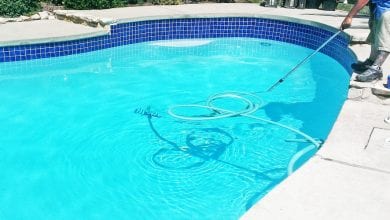
How To Open A Pool?
After the cold winter that seems to go on forever, any responsible pool owner will need to know how to open a pool for the summer. This is in a sense, a reverse of winterproofing the pool and will set you up for an enjoyable swim season ahead. It’s not as simple as throwing some chemicals in and jumping into the water which is why we are here. However, it is also easy enough when you know what you are doing. The following article details everything there is to know when opening a pool for summer.
Preparing
The first stage all starts with a bit of planning. Sure the cover looks a bit sorry for itself after a full season of protecting the pool, but before you start to remove the clamps, let’s make sure you have everything you need.
Although a lot of people rush the process, it is unwise. Choosing the right protective gear is important as pool chemicals are to be handled sensibly. This, as well as all the regular supplies for proper pool maintenance (something that should start alongside opening the pool), should be gathered before getting started. Some of the following are more important than others:
- Pool pump cover
- Cover cleaner
- Broom
- Chemical kit
- Thread seal tape
- Skimmer
- Garden hose
- Goggles
- Chemical resistant protective gloves
- Test Strips/Pool test kit
- Pool shock
We recommend keeping an ample supply of all the common chemicals required for pool maintenance rather than testing than having to go out and source them. These include chlorine, pH increaser, and decreaser, calcium hardness increaser, water clarifier, algaecide, and alkaline increaser among others.
How To Open A Pool
Ok, if the sun is blazing, take the necessary protection in terms of sunscreen and wearing a t-shirt (a polo with a collar can protect your neck as you work up a sweat).
Start With The Cover
You can’t open a pool for summer until you can get to the water. Cleaning the cover before removing it is a good idea which is where the broom helps to push twigs and other debris out of the way. Then, use a pool cover pump to remove any excess water that has piled up over the season. This shouldn’t take too long as long as you have a decent pump.
Removing the cover should be easy enough on your own but having a buddy to help will make the task a lot easier. Cleaning it after laying it on an even surface will help increase its longevity so it can be used for multiple winters. Make sure it is not showing signs of damage before using the cover cleaner. If it is, it can be disposed of and replaced.
It might be a good idea to check the dimensions of the cover before purchasing another to make life easier. All being well, a scrub and a clean will have it ready for storage – be sure to let it dry before putting it away to avoid creating an environment for mold to form. Avoid using a broom or brush with harsh bristles – soft will do here for protecting the cover. Any pool pillows used to prevent ice from damaging the pool can be given the same treatment and stored in the same way.
Time To Skim
Now you are faced with cleaning the water, and it all starts with skimming. Use a pool net to remove any stray leaves and sticks that have managed to find their way in. This will protect the working parts when they are switched back on and ensures the chemicals aren’t having to work harder because of stray debris.
Reattach Any Plugs
Not everyone removes their pipes to stop them from freezing or installs plugs, but if you have, now is the time to put them back in place. Hopefully, they were stored somewhere dry and there are no signs of mold. Water should then flow back into the pipes and a clear sign of this will show in the form of bubbles.
Pop The Accessories Back In
This involves any ladders, but also means any slides and other accessories used around the pool. Now is the time to put them back into place. A quick rinse might be necessary to ensure you aren’t putting dust into the pool you just skimmed the top of.
Top Up The Pool
Although you shouldn’t expect to unveil a half-full pool, it will most likely have lost some of its water. Now is the time to add more to bring it up to the normal level, especially if it has dipped below the level of the jets. Also, it is better to add the water so when using a test kit later, it provides a true reading of what chemicals are needed.
Time To Get The Filter Ready
Nothing should be on as of yet, so consider this part of the prepping process still. Make sure all drain plugs are back in place, inspect the O-ring to make sure it doesn’t need replacing before lubricating it as you go. Open the return side valves, this will provide a place for the water to go. Anyone with a multiport valve will need to switch the handle onto waste and be sure that the pressure gauge is replaced.
Next, turn on the pump, and wait for the water to flow so you know it is primed. This is also a good opportunity to give the filter a clean should it need it as this will give the pool its best chance of keeping the water clean for as long as possible. Again, if you have a multiport valve, switch it to filter.
It might be necessary to prime the pool again if there is a surge of water as this can mean there is something blocking water flow. Switch off the pump and prime the pool again if this is the case.
Vacuum The Pool
Although scrubbing the sides with the vacuum can do enough to ensure the pool shock is effective, it is fine to give it an additional brush before vacuuming to help it be as effective as possible. Either way, vacuuming the sides and bottom of the pool is going to be important as it hasn’t be done in months. Expect it to take a little longer than usual as the sediment on the bottom will have built up but it is good practice for the coming pool maintenance throughout the swim season.
Test The Water
This is where you would usually swipe the test kit into the water and judge for yourself. However, because the pool has been left without any maintenance for months on end, it can be a good idea to get it tested properly. Taking a sample to your local pool supply store can help provide an accurate reading.
If you are confident in taking a reading then you can judge for yourself. A test strip or test kit will help you find out how much chlorine to add, as well as the alkalinity, the pH balance, and the calcium hardness. Add the appropriate level of chemicals.
Shock The Pool
The need to do this might be evident in the color of the water, andy green tint or worse will mean the algae has built up under the cover. Whether it is clearer or cloudier, it is a good idea to give the water a kick start and use a pool shock. Not only does it give a more intense clean, but it kills bacteria and algae and allows the chemicals to do their job.
For a pool opening, a double shock is a good idea. Follow the instructions on the bottle and work out how much to pour. It is always a good idea to wear the safety equipment for this stage as we are talking about some pretty strong stuff. Circle the pool, pouring the shock in for an even spread. It is possible to mix it with water before pouring in, again, follow the instructions unique to the brand you are using.
Leave The Filter On
Because of the additional chemicals, it is now a good idea to leave the filter running for a full 24 hours. This will help the shock to mix with the water, and get rid of the algae and other bacteria more effectively.
After a day of waiting, the water should be clear, clean, and very tempting. Test the levels again to be sure, and if there is any cloudiness then do not fret. This is common after using shock. Either wait a bit longer or add a water clarifier. There is no harm in testing the chemical levels just to be on the safe side. Follow these steps, and you have just opened your pool for summer.
A Few Notes On Safety
So, the pool is ready to go and you have the trunks to hand, and swimming accessories inflated. Before getting in, make sure the area is safe for you and other swimmers by following some last-minute safety advice. After adding chemicals, especially the likes of shock, there is always a chance that some have spilled around the pool area. Use a hose to dilute and move it away from where people may stand on it. A lot of people let their guard down when it comes to safety after re-opening their pool. Because the idea of having fun is strong, safety gates and pool alarms are often neglected. Test them before kids and pets are allowed anywhere near.
Because it has been a long time since the pool was used, and the filter has been working, and the chemicals have been added, it is always a good idea to continually test the water. There is nothing wrong with one last check before you are ready to jump in.
Finally, store all the winterizing parts such as the cover and other items safely out of the way where they can either attract mold, or pests such as rodents as they will provide a tempting place to nest. Then store chemicals where you can access them to add more throughout the high season, but in a place that is out of reach for children and pets.
Enjoy Your Open Pool
It’s time to call the kids outside, ring your friends and family, and tell them that the pool is open for business again! Often less painful than winterizing the pool, opening it at least offers the prospect of being able to use t imminently. After following the above steps, the water should be clear, clean, and ready to be enjoyed.
Stay on top of the regularly maintained to ensure it is safe every day of the week and enjoy the coming months of swimming.
FAQ
How Long Does It Take To Open A Pool For Summer?
The process itself doesn’t take long, with a lot of the steps taking a few minutes. However, allowing the pool shock to do its job can take up to 24 hours. This means it will be a little over a day. There are pool shocks that take less time, but because the water has been neglected over winter, it is going to need more time.
What Happens If You Don’t Open A Pool For Summer?
If you don’t anticipate using the pool over the summer, it is still a good idea to follow the steps to ensure the water is safe and the working parts are in good condition. After the shock has had a chance to settle, the pool will need to be maintained as the heat will cause the chemicals to evaporate so there will still be a level of pool maintenance required. It can still be covered throughout the summer.
When Should You Open A Pool For Summer?
A good time is around two weeks before you intend to use it. This gives the pool a chance to heat up, and the chemicals time to settle. It can be done last minute then enjoyed soon after the pool shock has had the proper time to work.







